Showing Spotlights 449 - 456 of 544 in category All (newest first):
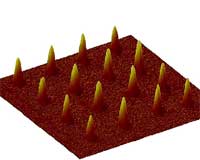 Past studies of photo-responsive proteins have generally dwelled on applications for energy-saving computer displays, light-based computing or computer memory. The general theme in the research tends to rely on the controllable and quick state change of the protein. But, the ability of the protein to actually incite a physical change in a composite macroscopic system has been largely unexplored. Harnessing this ability of the protein to incite change in a polymeric material could have broad implications in the field of biomedical and materials engineering. Getting bacteriorhodopsin to 'play ball' with other bulk materials could render those materials sensitive to a light. As a stimulus, light is often much easier to control than those typically explored by researchers such as bulk pH, temperature or electric fields.
Past studies of photo-responsive proteins have generally dwelled on applications for energy-saving computer displays, light-based computing or computer memory. The general theme in the research tends to rely on the controllable and quick state change of the protein. But, the ability of the protein to actually incite a physical change in a composite macroscopic system has been largely unexplored. Harnessing this ability of the protein to incite change in a polymeric material could have broad implications in the field of biomedical and materials engineering. Getting bacteriorhodopsin to 'play ball' with other bulk materials could render those materials sensitive to a light. As a stimulus, light is often much easier to control than those typically explored by researchers such as bulk pH, temperature or electric fields.
Dec 13th, 2007
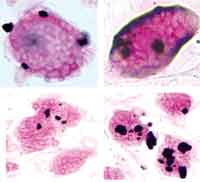 Carbon nanotubes (CNTs) have shown promise as an important new class of multifunctional building blocks and innovative tools in a large variety of nanotechnology applications, ranging from nanocomposite materials through nanoelectronics to biomedical devices (e.g. gene and drug carriers). The recent rapid development in nanotechnology has renewed the pressing demand for large-scale production of CNTs for potential applications in commercial products. The number of industrial-scale facilities for the increasingly low-cost production of multi-walled carbon nanotubes (MWCNTs) continues to grow, and with that the professional and public exposure to MWCNTs is expected to increase significantly in the coming years. Owing to their unusual one-dimensional hollow nanostructure and unique physicochemical properties, CNTs are particularly useful as novel drug delivery tools and imaging agents. However, such biomedical, and many other related, applications will not be realized if there is no proper assessment of the potential hazards of CNTs to humans and other biological systems. This situation prompted a group of researchers to carry out the first genotoxicity study of nanomaterials. Although the health effects of nanomaterials have attracted considerable attention, the scientific community has thus far focused primarily on the studies of nanomaterials toxicity at the cellular level. Very little is known about the toxicity at the molecular level, or genotoxicity, of nanomaterials in mammalian cells. Researchers at the University of Dayton have assessed the DNA damage response to MWCNTs in mouse embryonic stem cells (ES). This new work emphasizes the importance of careful scrutiny of the genotoxicity of nanomaterials.
Carbon nanotubes (CNTs) have shown promise as an important new class of multifunctional building blocks and innovative tools in a large variety of nanotechnology applications, ranging from nanocomposite materials through nanoelectronics to biomedical devices (e.g. gene and drug carriers). The recent rapid development in nanotechnology has renewed the pressing demand for large-scale production of CNTs for potential applications in commercial products. The number of industrial-scale facilities for the increasingly low-cost production of multi-walled carbon nanotubes (MWCNTs) continues to grow, and with that the professional and public exposure to MWCNTs is expected to increase significantly in the coming years. Owing to their unusual one-dimensional hollow nanostructure and unique physicochemical properties, CNTs are particularly useful as novel drug delivery tools and imaging agents. However, such biomedical, and many other related, applications will not be realized if there is no proper assessment of the potential hazards of CNTs to humans and other biological systems. This situation prompted a group of researchers to carry out the first genotoxicity study of nanomaterials. Although the health effects of nanomaterials have attracted considerable attention, the scientific community has thus far focused primarily on the studies of nanomaterials toxicity at the cellular level. Very little is known about the toxicity at the molecular level, or genotoxicity, of nanomaterials in mammalian cells. Researchers at the University of Dayton have assessed the DNA damage response to MWCNTs in mouse embryonic stem cells (ES). This new work emphasizes the importance of careful scrutiny of the genotoxicity of nanomaterials.
Dec 11th, 2007
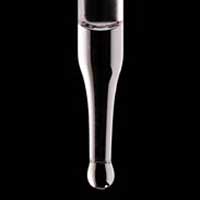 Pipettes (from the French: little pipe) are one of those ubiquitous tools you find in every chemical, medical or biology lab. The original pipette is made of glass and it works by creating a vacuum above the liquid-holding chamber and selectively releasing this vacuum to draw up and dispense liquid. With the advance of molecular biology, researchers required pipettes that were able to confine smaller and smaller amounts of specimen, not only for probing but also for injecting drugs, DNA etc. into cells - without damaging the cells, of course. Just a few months ago, researchers at the Brookhaven National Laboratory have developed what is thought to be the world's smallest pipette: made of a carbon-coated germanium nanowire it can hold a volume of only a few zeptoliters (a billionth of a trillionth of a liter, or one thousand cubic nanometers). Although today it even is possible to process the tip of a glass pipette to have an inner diameter as small as several tens of nanometers, this involves considerable problems in terms of the processing accuracy and the operability of the pipette, particularly in terms of locating the tip. It is generally considered that probes made from carbon nanotubes (CNTs) and nanoscale carbon pipes offer an attractive alternative to glass pipettes because of their small size, high mechanical strength, and high electrical conductivity. Researchers at the University of Pennsylvania have developed a manufacturing technique for carbon nanopipettes (CNPs) that does not require cumbersome nanoassembly and is amenable to mass production.
Pipettes (from the French: little pipe) are one of those ubiquitous tools you find in every chemical, medical or biology lab. The original pipette is made of glass and it works by creating a vacuum above the liquid-holding chamber and selectively releasing this vacuum to draw up and dispense liquid. With the advance of molecular biology, researchers required pipettes that were able to confine smaller and smaller amounts of specimen, not only for probing but also for injecting drugs, DNA etc. into cells - without damaging the cells, of course. Just a few months ago, researchers at the Brookhaven National Laboratory have developed what is thought to be the world's smallest pipette: made of a carbon-coated germanium nanowire it can hold a volume of only a few zeptoliters (a billionth of a trillionth of a liter, or one thousand cubic nanometers). Although today it even is possible to process the tip of a glass pipette to have an inner diameter as small as several tens of nanometers, this involves considerable problems in terms of the processing accuracy and the operability of the pipette, particularly in terms of locating the tip. It is generally considered that probes made from carbon nanotubes (CNTs) and nanoscale carbon pipes offer an attractive alternative to glass pipettes because of their small size, high mechanical strength, and high electrical conductivity. Researchers at the University of Pennsylvania have developed a manufacturing technique for carbon nanopipettes (CNPs) that does not require cumbersome nanoassembly and is amenable to mass production.
Dec 7th, 2007
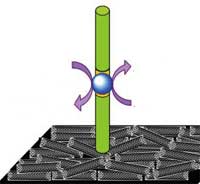 Molecular bioelectronics is a rapidly progressing research field that is concerned with the movement of electrons and ions within living systems. This field brings together the strengths of biological reactions and biochemical interactions from nature with electronic signal detection and amplification of human electronics technology. The result will be new applications in medicine, diagnostics and therapeutics that would never be imaginable within the limitations of each separated domain. One day, bioelectronic devices could even be be directly involved in electrical communication with signal producing or controlling molecules, organelles or structures within our bodies. A more short-term goal, though, is the development of biosensors (such as enzyme-based sensors and DNA sensors) to combine the extraordinary specificity of biochemical receptors with general purpose microelectronics to develop selective probes for diagnostics, drug screening, and toxin detection. An example of recent advances in the field is the work of researchers in the U.S. who have designed an integrated nanobioelectronic system, exploiting the distinct properties of nanowires and carbon-nanotubes, for triggering reversibly and on-demand bioelectrocatalytic transformations of alcohols. Such an adaptive magneto-switchable nanobioelectronic system exploits the distinct properties of its individual nanomaterial components, can be extended to a wide range of biocatalytic systems, and offers great promise for regulating the operation of biofuel cells, bioreactors, and biosensing devices in response to specific needs.
Molecular bioelectronics is a rapidly progressing research field that is concerned with the movement of electrons and ions within living systems. This field brings together the strengths of biological reactions and biochemical interactions from nature with electronic signal detection and amplification of human electronics technology. The result will be new applications in medicine, diagnostics and therapeutics that would never be imaginable within the limitations of each separated domain. One day, bioelectronic devices could even be be directly involved in electrical communication with signal producing or controlling molecules, organelles or structures within our bodies. A more short-term goal, though, is the development of biosensors (such as enzyme-based sensors and DNA sensors) to combine the extraordinary specificity of biochemical receptors with general purpose microelectronics to develop selective probes for diagnostics, drug screening, and toxin detection. An example of recent advances in the field is the work of researchers in the U.S. who have designed an integrated nanobioelectronic system, exploiting the distinct properties of nanowires and carbon-nanotubes, for triggering reversibly and on-demand bioelectrocatalytic transformations of alcohols. Such an adaptive magneto-switchable nanobioelectronic system exploits the distinct properties of its individual nanomaterial components, can be extended to a wide range of biocatalytic systems, and offers great promise for regulating the operation of biofuel cells, bioreactors, and biosensing devices in response to specific needs.
Dec 6th, 2007
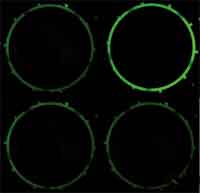 The human body so far is the ultimate 'wet computer' - a highly efficient, biomolecule-based information processor that relies on chemical, optical and electrical signals to operate. Researchers are trying various routes to mimic some of the body's approaches to computing. Especially research related to molecular logic gates is a fast growing and very active area. Already, common logic gates, which are used in conventional silicon circuitry, can be also mimicked at the molecular level. Chemists have reported that a molecular logic gate has the potential for calculation on the nanometer scale, which is unparalleled in silicon-based devices. The general character of the concept of binary logic allows the substitution of electrical signals by chemical and optical signals, which for example opens access to a vast pool of photoactive molecules to be used for the purpose of molecular logic. Molecular logic gate structures using fluorescence changes have been studied intensively using various inputs, such as pH, metal ions, and anions. Now, South Korean scientists using solutions of fluorescent sensor molecules - and, for the first time, proteins - have developed the first soluble molecular logic gates. By using a microfluidic device, input solutions are routed into a central loop, which is filled with a fluorescent sensor solution. There the solutions mix and, in certain combinations, switch the fluorescence 'output' on or off.
The human body so far is the ultimate 'wet computer' - a highly efficient, biomolecule-based information processor that relies on chemical, optical and electrical signals to operate. Researchers are trying various routes to mimic some of the body's approaches to computing. Especially research related to molecular logic gates is a fast growing and very active area. Already, common logic gates, which are used in conventional silicon circuitry, can be also mimicked at the molecular level. Chemists have reported that a molecular logic gate has the potential for calculation on the nanometer scale, which is unparalleled in silicon-based devices. The general character of the concept of binary logic allows the substitution of electrical signals by chemical and optical signals, which for example opens access to a vast pool of photoactive molecules to be used for the purpose of molecular logic. Molecular logic gate structures using fluorescence changes have been studied intensively using various inputs, such as pH, metal ions, and anions. Now, South Korean scientists using solutions of fluorescent sensor molecules - and, for the first time, proteins - have developed the first soluble molecular logic gates. By using a microfluidic device, input solutions are routed into a central loop, which is filled with a fluorescent sensor solution. There the solutions mix and, in certain combinations, switch the fluorescence 'output' on or off.
Dec 5th, 2007
 Talking about the threat of terrorists using bioweapons is a great tool for scaring people. Using any kind of pathogen (bacterium, virus or other disease-causing organism) as a weapon certainly is a terrifying scenario; think about the near-panic the 2001 anthrax attacks in the United States caused. Letters containing anthrax spores were mailed to several news media offices and two U.S. Senators, killing five people and infecting 17 others. Can you image what panic would result from an attack that kills 5,000 people and causes 76 million illnesses? Well, as a matter of fact, foodborne diseases cause approximately 76 million illnesses, 325,000 hospitalizations, and 5,000 deaths in the United States each year. Known pathogens account for an estimated 14 million illnesses, 60,000 hospitalizations, and 1,800 deaths. The Food and Drug Administration's 2005 Food Code states that the estimated cost of foodborne illness is $10-$83 billion annually. So while the U.S. spends billions of dollars securing its borders, it loses many more billions, not to mention thousands of lives, every year by not being able to keep its spinach and hamburgers safe. Apparently, talking about terrorism is much better political theater (and makes for catchier Nanowerk Spotlight titles) than discussing E. coli outbreaks. However, be it because of potential terrorists or actual contaminated food, research in microbial detection and decontamination processes increased significantly over the past years. Traditional methods of identifying and subsequently removing a pathogen are slow and cumbersome. Now, using nanotechnology, researchers have designed a novel biosensing system that can identify E. coli in just five minutes and remove up to 88% of the target bacteria.
Talking about the threat of terrorists using bioweapons is a great tool for scaring people. Using any kind of pathogen (bacterium, virus or other disease-causing organism) as a weapon certainly is a terrifying scenario; think about the near-panic the 2001 anthrax attacks in the United States caused. Letters containing anthrax spores were mailed to several news media offices and two U.S. Senators, killing five people and infecting 17 others. Can you image what panic would result from an attack that kills 5,000 people and causes 76 million illnesses? Well, as a matter of fact, foodborne diseases cause approximately 76 million illnesses, 325,000 hospitalizations, and 5,000 deaths in the United States each year. Known pathogens account for an estimated 14 million illnesses, 60,000 hospitalizations, and 1,800 deaths. The Food and Drug Administration's 2005 Food Code states that the estimated cost of foodborne illness is $10-$83 billion annually. So while the U.S. spends billions of dollars securing its borders, it loses many more billions, not to mention thousands of lives, every year by not being able to keep its spinach and hamburgers safe. Apparently, talking about terrorism is much better political theater (and makes for catchier Nanowerk Spotlight titles) than discussing E. coli outbreaks. However, be it because of potential terrorists or actual contaminated food, research in microbial detection and decontamination processes increased significantly over the past years. Traditional methods of identifying and subsequently removing a pathogen are slow and cumbersome. Now, using nanotechnology, researchers have designed a novel biosensing system that can identify E. coli in just five minutes and remove up to 88% of the target bacteria.
Dec 3rd, 2007
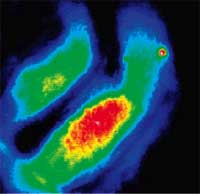 Nanotechnology's poster child, the carbon nanotube (CNT), has been explored for use in many technical applications. Increasingly, researchers are also looking at the unique biological properties of CNTs for potential biomedical uses. For instance, the interaction between DNA and CNTs have been explored and DNA-functionalized nanotubes hold significant promise as nucleic acid sensors. Nanotubes have also been considered for use as scaffolds for cells in tissue engineering. No matter what their intended function, any material used in medicine must exhibit - among other compatibility factors - biocompatibility, non-toxicity and non-carcinogenicity. And here the jury is still out as far as CNTs are concerned. One limiting factor of toxicological studies so far has been the use of animal tissue rather than living specimen. Researchers have now succeeded in detecting single-walled CNTs (SWCNTs) inside living animals - with surprisingly benign results - paving the way for future research on the effects and fate of nanotubes inside living organisms.
Nanotechnology's poster child, the carbon nanotube (CNT), has been explored for use in many technical applications. Increasingly, researchers are also looking at the unique biological properties of CNTs for potential biomedical uses. For instance, the interaction between DNA and CNTs have been explored and DNA-functionalized nanotubes hold significant promise as nucleic acid sensors. Nanotubes have also been considered for use as scaffolds for cells in tissue engineering. No matter what their intended function, any material used in medicine must exhibit - among other compatibility factors - biocompatibility, non-toxicity and non-carcinogenicity. And here the jury is still out as far as CNTs are concerned. One limiting factor of toxicological studies so far has been the use of animal tissue rather than living specimen. Researchers have now succeeded in detecting single-walled CNTs (SWCNTs) inside living animals - with surprisingly benign results - paving the way for future research on the effects and fate of nanotubes inside living organisms.
Nov 7th, 2007
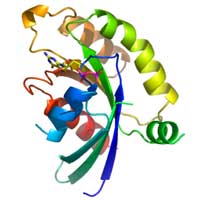 Proteins, large organic compounds made of amino acids, provide many of the most basic units of function in living systems. They make up about half of the dry mass of animals and humans. There may be as many as 1 million different types of proteins in the human body (it is estimated that the human proteome is comprised of an average of 5-7 protein isoforms per open reading frame in the human genome and a further 600 000-odd immunoglobulins present in serum at any given moment) - nobody really knows. The word protein comes from the Greek prota, meaning 'of primary importance', and they actually may become of great importance in nanoscale fabrication as well. Proteins have an amazing number of functions inside our bodies: Enzymes serve as catalysts to break down food into various components; transport proteins such as hemoglobin transport molecules (e.g. oxygen); storage proteins store molecules (e.g. iron is stored in the liver as a complex with the protein ferritin); structural proteins such as keratin or collagen are needed for mechanical support in tissues like cartilage and skin but also hair and nails; proteins are the major component of muscles and for instance actin or myosin are key to contracting muscle fibers; hormones control the growth of cells and their differentiation; antibody proteins are needed for immune protection; and toxins are, well, toxic, but in minute amounts could have beneficial medical properties. Scientists believe that this variety of natural protein functions - actuation, catalysis, structural transport and molecular sequestering - could serve as valuable and versatile building blocks for synthesis of functional materials. Researchers now have found that nanometer-scale changes in protein conformation can be translated into macroscopic changes in material properties. The result is a new class of dynamic, protein-based materials.
Proteins, large organic compounds made of amino acids, provide many of the most basic units of function in living systems. They make up about half of the dry mass of animals and humans. There may be as many as 1 million different types of proteins in the human body (it is estimated that the human proteome is comprised of an average of 5-7 protein isoforms per open reading frame in the human genome and a further 600 000-odd immunoglobulins present in serum at any given moment) - nobody really knows. The word protein comes from the Greek prota, meaning 'of primary importance', and they actually may become of great importance in nanoscale fabrication as well. Proteins have an amazing number of functions inside our bodies: Enzymes serve as catalysts to break down food into various components; transport proteins such as hemoglobin transport molecules (e.g. oxygen); storage proteins store molecules (e.g. iron is stored in the liver as a complex with the protein ferritin); structural proteins such as keratin or collagen are needed for mechanical support in tissues like cartilage and skin but also hair and nails; proteins are the major component of muscles and for instance actin or myosin are key to contracting muscle fibers; hormones control the growth of cells and their differentiation; antibody proteins are needed for immune protection; and toxins are, well, toxic, but in minute amounts could have beneficial medical properties. Scientists believe that this variety of natural protein functions - actuation, catalysis, structural transport and molecular sequestering - could serve as valuable and versatile building blocks for synthesis of functional materials. Researchers now have found that nanometer-scale changes in protein conformation can be translated into macroscopic changes in material properties. The result is a new class of dynamic, protein-based materials.
Nov 6th, 2007
 Past studies of photo-responsive proteins have generally dwelled on applications for energy-saving computer displays, light-based computing or computer memory. The general theme in the research tends to rely on the controllable and quick state change of the protein. But, the ability of the protein to actually incite a physical change in a composite macroscopic system has been largely unexplored. Harnessing this ability of the protein to incite change in a polymeric material could have broad implications in the field of biomedical and materials engineering. Getting bacteriorhodopsin to 'play ball' with other bulk materials could render those materials sensitive to a light. As a stimulus, light is often much easier to control than those typically explored by researchers such as bulk pH, temperature or electric fields.
Past studies of photo-responsive proteins have generally dwelled on applications for energy-saving computer displays, light-based computing or computer memory. The general theme in the research tends to rely on the controllable and quick state change of the protein. But, the ability of the protein to actually incite a physical change in a composite macroscopic system has been largely unexplored. Harnessing this ability of the protein to incite change in a polymeric material could have broad implications in the field of biomedical and materials engineering. Getting bacteriorhodopsin to 'play ball' with other bulk materials could render those materials sensitive to a light. As a stimulus, light is often much easier to control than those typically explored by researchers such as bulk pH, temperature or electric fields.
 Subscribe to our Nanotechnology Spotlight feed
Subscribe to our Nanotechnology Spotlight feed





